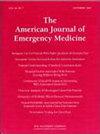院前高保真临床模拟中医学生的阈值焦虑:随机临床试验
IF 2.7
3区 医学
Q1 EMERGENCY MEDICINE
引用次数: 0
摘要
本研究的目的是确定医学生进行院前重症监护高保真临床模拟(脓毒症、心肌梗死、多发创伤和过敏性休克)的逐案分析的焦虑指数(模拟前和模拟后)。次要结果是确定导致极度焦虑水平的临床情景(>;25%模拟后与模拟前的δ焦虑)。方法于2022年9月20日至2024年4月15日在西班牙巴利亚多利德大学医学院高级临床模拟中心进行随机(4例院前重症病例)、基于模拟的盲法临床试验,志愿者为大四医学生(6年级)。对调查问卷、流行病学资料和生活习惯进行评估。主要结果是STAI状态子量表上的δ焦虑水平(模拟前和模拟后)。结果共有342名受试者符合纳入标准。中位年龄23岁(IQR: 23 - 24;范围:22 ~ 41例),女性占67.8%(213例)。情景分析显示,性别、年龄、先前的模拟训练或在模拟情景中的角色(领导者或助手)没有显著差异。多重创伤情景在STAI状态子量表上的模拟后评估最差,中位数为54分(IQR: 46-66) (p <;0.001)。结论在高保真临床模拟中,多发创伤和过敏性休克情景更容易诱发医学生的极度焦虑水平。教育工作者必须意识到这些潜在的焦虑水平,并仔细设计场景,提供充分的准备和促进有效的汇报,以优化学习和减轻过度焦虑的负面影响。本文章由计算机程序翻译,如有差异,请以英文原文为准。
Threshold-anxiety in medical students performing a prehospital high-fidelity clinical simulation: Randomized clinical trial
Background
The aim of this study was to determine the delta anxiety index (pre- and post-simulation) of medical students performing prehospital critical care high-fidelity clinical simulations (sepsis, myocardial infarction, polytrauma and anaphylactic shock) case-by-case. The secondary outcome was to identify clinical scenarios resulting in extreme anxiety levels (> 25 % post-simulation vs. pre-simulation delta anxiety).
Methods
A randomized (four prehospital critical care cases), blind, simulation-based clinical trial was performed at the Advanced Clinical Simulation Center of the Medical School of Valladolid University (Spain) with the participation of volunteer last-year medical students (6th year) from September 20, 2022, to April 15, 2024. The STAI questionnaire, epidemiological data and lifestyle habits were assessed. The principal outcome was the delta anxiety level (pre- and post-simulation) on the state subscale of the STAI.
Results
A total of 342 participants met the inclusion criteria. The median age was 23 years (IQR: 23–24; range: 22–41), and 67.8 % were female (213 cases). Scenario-by-scenario analysis revealed no significant differences by sex, age, prior simulation training, or role in the simulated scenario (leader or assistant). The polytrauma scenario yielded the worst post-simulation evaluation on the state subscale of the STAI, with a median of 54 points (IQR: 46–66) (p < 0.001).
Conclusion
Polytrauma and anaphylactic shock scenarios are more likely to induce extreme anxiety levels in final-year medical students during high-fidelity clinical simulations. Educators must be aware of these potential anxiety levels and carefully design the scenarios, providing adequate preparation and facilitating effective debriefing to optimize learning and mitigate the negative effects of excessive anxiety.
求助全文
通过发布文献求助,成功后即可免费获取论文全文。
去求助
来源期刊
CiteScore
6.00
自引率
5.60%
发文量
730
审稿时长
42 days
期刊介绍:
A distinctive blend of practicality and scholarliness makes the American Journal of Emergency Medicine a key source for information on emergency medical care. Covering all activities concerned with emergency medicine, it is the journal to turn to for information to help increase the ability to understand, recognize and treat emergency conditions. Issues contain clinical articles, case reports, review articles, editorials, international notes, book reviews and more.

 求助内容:
求助内容: 应助结果提醒方式:
应助结果提醒方式:


